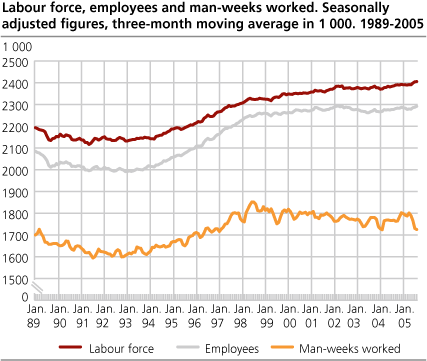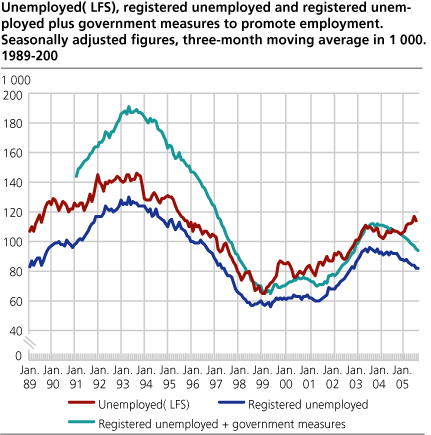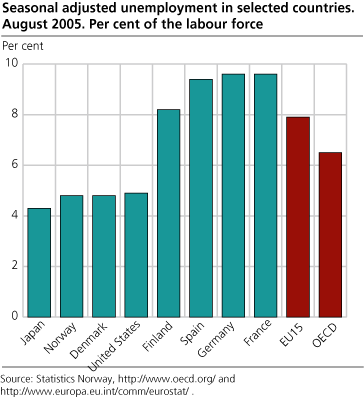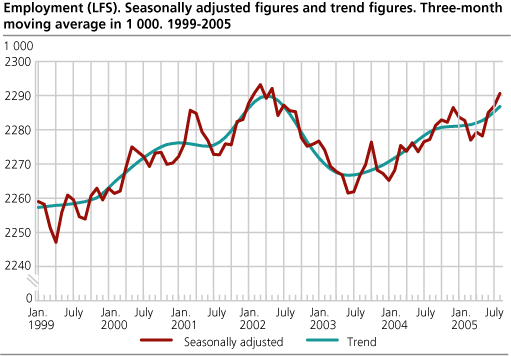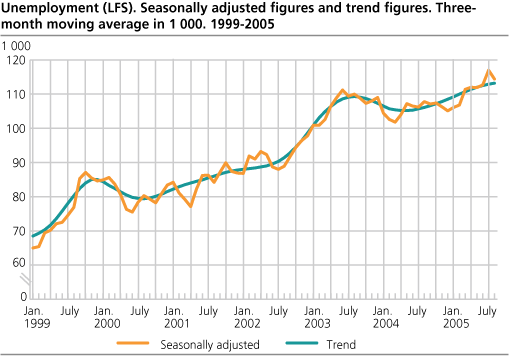Content
Published:
This is an archived release.
Rising employment
The number of employed people increased from the April-June period to the July-September period. The figures presented in this article are adjusted for seasonal variations.
Although the increase is within the LFS error margin, the new figures confirm the upward trend that has been seen since the summer of 2003.
Unemployment in August (the July-September period) was approximately unchanged from May (April-June). Following the growth in unemployment from 2004 to the beginning of 2005, unemployment has not changed much in the current period, according to the LFS. Seasonally adjusted figures of registered unemployment at job centres show a decline of 3 000 people.
Fall in unemployment internationally
The seasonally adjusted unemployment rate for Norway was 4.8 per cent in August 2005, up from 4.7 per cent in May. The rate in the EU area stayed unchanged at 7.9 per cent, while the OECD area saw a fall from 6.6 to 6.5 per cent. In the same period, the unemployment rate fell from 5.1 to 4.9 per cent in the USA, from 5.0 to 4.8 per cent in Denmark, and from 8.3 to 8.2 per cent in Finland. From May to August, the unemployment rate fell from 9.8 to 9.6 per cent in France, while Germany had an increase from 9.5 to 9.6 per cent, according to figures from the OECD and Eurostat .
Decline in man-weeks worked
From May to August, man-weeks worked fell by 65 000, which is clearly outside the LFS error margin. The decline must be seen in connection with the strong increase in the number of people on vacation leave in the summer months (June, July and August) this year compared with 2004 (and 2003). The increase is particularly strong in July and August. One would expect that the total level of vacation leave in the summer months was similar to the previous year, but the LFS figures indicate a change in the vacation pattern. As a result, the seasonal-adjustment method is not fully able to measure the trend in man-weeks worked at the moment.
Uncertain figures
Quality tests show that the seasonally adjusted LFS unemployment figures are uncertain. The seasonal-adjustment method has problems identifying a stable seasonal pattern for this series. The random component is relatively large compared with the seasonal component. The figures should therefore be treated with caution.
The purpose of adjusting for seasonal variations is to describe the development over the last year and provide figures of change between the last two three-month periods, corrected for normal seasonal variations. In order to reduce uncertainty, the published series are three-month moving averages of the seasonally adjusted figures. For instance, the figures for August represent the average of the estimates for July, August and September.
Tables:
The statistics is published with Labour force survey.
Contact
-
Arbeidsmarked og lønn
E-mail: arbeidsmarked@ssb.no
-
Erik Herstad Horgen
E-mail: erik.horgen@ssb.no
tel.: (+47) 93 08 68 62

